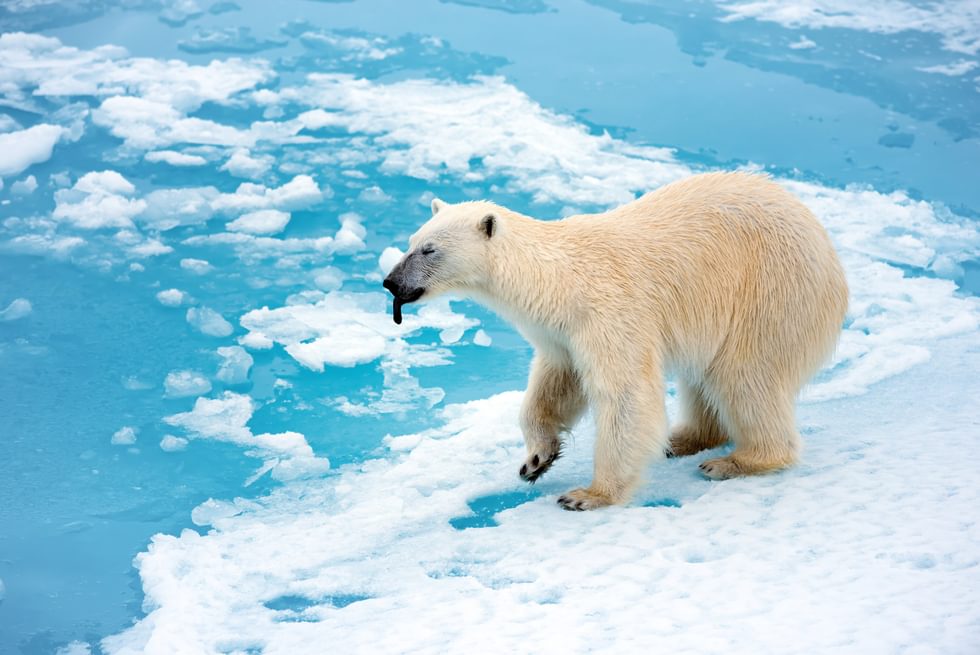The Biggest, the Best, the Most, the Last: Alaska on the Edge
From the Series: Arctic Abstractive Industry
From the Series: Arctic Abstractive Industry

These days, talk about the far North is saturated with superlatives. Nowhere is this more evident than in Alaska, a place that sells itself as the last frontier. All manner of media—from popular news coverage to activist alerts to policymaking briefs—paint extreme portraits of this corner of the Arctic: it faces the biggest threats to some of the world's “last wild places” on the one hand, and it holds "unparalleled opportunities" for prosperity and security from a new era of polar resource development on the other. These assertions of off-the-charts Arctic incomparability are mobilized toward very different ends, from major projects for environmental protection to redoubled extractive ambitions. Yet they converge in positioning Alaska at the extreme. In an earlier era, representations of Alaska as a site of larger-than-life conditions helped establish it in the popular imagination as a proving ground for pioneering prospectors, hardy adventurers, and others seeking to shore up their own fortunes and those of the settler-colonial nation-state. Today, however, the future of life itself seems to hang in the balance.
What does it mean to inhabit a place that is increasingly imagined as harboring perils and promises at the planetary scale? Our recent ethnographic research suggests that for those in the crosshairs of controversial resource development designs, such as large-scale mining and logging in ecologically sensitive zones, vulnerability is no longer a condition to be overcome but is itself a mode of gaining and deploying power.
Over the past few years, we have conducted collaborative fieldwork on either side of Alaska’s subarctic coast: Bristol Bay in southwestern Alaska, and the area around Sitka in southeastern Alaska.1 Bristol Bay faces threats from a controversial proposed mine in what is often described as one of the last, best wild salmon ecosystems on earth, while southeast Alaska is home to ongoing debates over logging in the world’s largest remaining temperate rainforest. Both regions depend heavily on commercial, recreational, and subsistence fisheries, whose longer-term futures are darkened by climate change and ocean acidification.
In and across these sites, we are examining how engagement with an environment at risk transforms the longtime pursuit of making a living from nature. Given Alaska’s superlative status in the varied economies that drive interactions with the environment today, it presents a prime site for examining the tensions of what Kim Fortun (2012, 447) has called late industrialism, whose future is “promised and motored by neoliberalism, bolstered by digital infrastructure and wealth but still energized by coal and oil.” If this condition characterizes the world at large, then the Arctic now sits on its precipitous edge. Among Arctic locations, where histories of neglect and unresolved claims are only recently giving way to agreements aimed at development, Alaska—with its decades-old Native claims settlement and aging oil pipeline—stands out as a spot that may well represent a picture of things to come.
The people living along Alaska’s coasts have long fashioned livelihoods through a sometimes uneasy negotiation of the multiple natures projected onto the circumpolar North. Its dual identities as a nearly inexhaustible storehouse of valuable natural resources and a critically vulnerable pristine reserve have been especially consequential. Yet the relationship between these historically opposed environmental visions appears to be changing, as invocations of imperilment spur the formation of new collectivities and forms of action in coastal Alaska. Our research with scientists, activists, government officials, and rural residents tracks the emergence of a political economy that manages the prospect of irreparable harm to coastal economies and ecosystems not as a limit, but as an opportunity.
Consider, for example, that charismatic and ecologically vulnerable species—particularly salmon—have emerged as an emblem of collective action against big extractive projects across both southeastern and southwestern Alaska. In the face of threats to life itself, these campaigns envision human futures through the vulnerability of another species. “Salmon is not about our differences, it’s about what we have in common,” contends one such effort, the Salmon Project, which urges Alaskans to “declare your life a salmon life” and organize to protect salmon. A similar campaign calls for declarations of citizenship to Salmon Nation: “a community of caretakers . . . that stretches across arbitrary boundaries . . . working together to improve our neighborhoods and watersheds.”
This push for a universalizing citizenship based on "mutual interest" in a keystone species by no means resolves deep and abiding social fractures. Often, we observed, when Alaskans maintained that certain salmon “belong to all of us,” this was deployed to delegitimize others’ claims, such as assertions of Alaska Native rights to historically significant fishing sites and methods of harvest. Yet efforts to assemble diverse people by way of salmon have forged powerful coalitions as well, especially in Bristol Bay, where they have helped flip the script on mining development from economically necessary to economically disastrous for fisheries-dependent livelihoods (Hébert 2016). Whereas economic prosperity once justified the large-scale extraction of Northern resources, the specter of ecological catastrophe enjoins Alaskans to reimagine their productive futures in the image of vulnerable others. As one Salmon Project initiative (and its accompanying clothing line) puts it: “The Alaskan life is a salmon life, worth living and protecting.” At stake is nothing less than a revaluation of life itself as a threatened resource in need of protection not from but for exploitation.
1. This project received support from the National Science Foundation’s Arctic Social Sciences Program (Award no. 1219390). We thank K. Alexandra Tuddenham, Taylor Rees, Samara Brock, Kendall Barbery, Austin Lord, and Alaire Hughey for their work on this project. We have blogged about our collaborative research here and here.
Fortun, Kim. 2012. “Ethnography in Late Industrialism.” Cultural Anthropology 27, no. 3: 446–64.
Hébert, Karen. 2016. “Chronicle of a Disaster Foretold: Scientific Risk Assessment, Public Participation, and the Politics of Imperilment in Bristol Bay, Alaska.” Journal of the Royal Anthropological Institute 22, S1: 108–26.